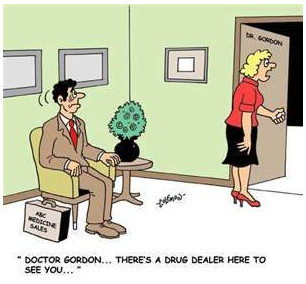Let’s
consider the way representatives for drug companies (pharma reps) run their
business. A pharma rep’s job is to visit doctors and convince them to purchase
medical equipment and drugs to treat everything from A(sthma) to Z(ollinger-Ellison
syndrome). First they may give a doctor a free pen with their logo, or perhaps
a notepad, a mug, or maybe some free drug samples. Those small gifts can subtly
influence physicians to prescribe a drug more often—all because they feel the
need to give back.
But
small gifts and free drug samples are just a few of the many psychological
tricks that pharma reps use as they set out to woo physicians. “They think of
everything,” my friend and colleague (let’s call him MD) told me. He went on to
explain that drug companies, especially smaller ones, train their reps to treat
doctors as if they were gods. And they seem to have a disproportionately large
reserve of attractive reps.
The
whole effort is coordinated with military precision. Every self-respecting rep
has access to a database that tells them exactly what each doctor has
prescribed over the last quarter (both that company’s drugs as well as their
competitors’). The reps also make it their business to know what kind of food
each doctor and their office staff likes, what time of day they are most likely
to see reps, and also which type of rep gets the most face time with the
doctors. If the doctor is noted to spend more time with a certain female rep,
they may adjust that rep’s rotation so that she can spend more time in that
office. If the doctor is a fan of the military, they’ll send him a veteran. The
reps also make it a point to be agreeable with the doctor’s outer circles, so
when the rep arrives they start by handing out candy and other small gifts to
the nurses and the front desk, securing themselves in everyone’s good graces
from the get-go.
One
particularly interesting practice is the “dine-and-dash,” where, in the name of
education, doctors can simply pull up at prespecified take-out restaurants and
pick up whatever they want. Even medical students and trainees are pulled into
some schemes. One particularly creative example of this strategy was the famous
black mug. A black mug with the company’s logo was handed out to doctors and
residents, and the company arranged it such that a doctor could take this mug
to any location of a local coffee chain (which shall go unnamed) and get as
much espresso or cappuccino as he or she wanted. The clamor for this mug was so
great that it became a status symbol among students and trainees. As these
practices became more extravagant, there was also more regulation from
hospitals and the American Medical Association, limiting the use of these
aggressive marketing tactics. Of course, as the regulations become more
stringent, pharma reps continue to search for new and innovative approaches to
influence physicians. And the arms race continues …
**
Hearing stories from the reps who sold medical devices was even more disturbing. We learned that it’s common practice for device reps to peddle their medical devices in the operating room in real time and while a surgery is under way.
Janet and I were surprised at how well the pharmaceutical reps understood classic psychological persuasion strategies and how they employed them in a sophisticated and intuitive manner. Another clever tactic that they told us about involved hiring physicians to give a brief lecture to other doctors about a drug they were trying to promote. Now, the pharma reps really didn’t care about what the audience took from the lecture—what they were actually interested in was the effect that giving the lecture had on the speaker. They found that after giving a short lecture about the benefits of a certain drug, the speaker would begin to believe his own words and soon prescribe accordingly.
Psychological studies show that we quickly and easily start believing whatever comes out of our own mouths, even when the original reason for expressing the opinion is no longer relevant (in the doctors’ case, that they were paid to say it). This is cognitive dissonance at play; doctors reason that if they are telling others about a drug, it must be good—and so their own beliefs change to correspond to their speech, and they start prescribing accordingly.
The reps told us that they employed other tricks too, turning into chameleons—switching various accents, personalities, and political affiliations on and off. They prided themselves on their ability to put doctors at ease. Sometimes a collegial relationship expanded into the territory of social friendship—some reps would go deep-sea fishing or play basketball with the doctors as friends. Such shared experiences allowed the physicians to more happily write prescriptions that benefited their “buddies.” The physicians, of course, did not see that they were compromising their values when they were out fishing or shooting hoops with the drug reps; they were just taking a well-deserved break with a friend with whom they just happened to do business. Of course, in many cases the doctors probably didn’t realize that they were being manipulated—but there is no doubt that they were.”
